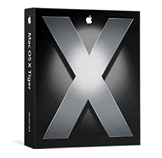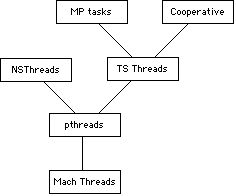No more mysteries: Apple's G5 versus x86, Mac OS X versus Linux
by Johan De Gelas on June 3, 2005 7:48 AM EST- Posted in
- Mac
Mac OS X: beautiful but...
The Mac OS X (Server) operating system can't be described easily. Apple:
While there are many very good ideas in Mac OS X, it reminds me a lot of fusion cooking, where you make a hotch-potch of very different ingredients. Let me explain.

Hexley the platypus, the Darwin mascot
Everything else is located in smaller programs, servers, which communicate with each other via ports and an IPC (Inter Process Communication) system. Explaining this in detail is beyond the scope of this article (read more here). But in a nutshell, a Mach microkernel should be more elegant, easier to debug and better at keeping different processes from writing in eachother's protected memory areas than our typical "monolithic" operating systems such as Linux and Windows NT/XP/2000. The Mach microkernel was believed to be the future of all operating systems.
However, you must know that applications (in the userspace) need, of course, access to the services of the kernel. In Unix, this is done with a Syscall, and it results in two context switches (the CPU has to swap out one process for another): from the application to the kernel and back.
The relatively complicated memory management (especially if the server process runs in user mode instead of kernel) and IPC messaging makes a call to the Mach kernel a lot slower, up to 6 times slower than the monolithic ones!
It also must be remarked that, for example, Linux is not completely a monolithic OS. You can choose whether you like to incorporate a driver in the kernel (faster, but more complex) or in userspace (slower, but the kernel remains slimmer).
Now, while Mac OS X is based on Mach 3, it is still a monolithic OS. The Mach microkernel is fused into a traditional FreeBSD "system call" interface. In fact, Darwin is a complete FreeBSD 4.4 alike UNIX and thus monolithic kernel, derived from the original 4.4BSD-Lite2 Open Source distribution.
The current Mac OS X has evolved a bit and consists of a FreeBSD 5.0 kernel (with a Mach 3 multithreaded microkernel inside) with a proprietary, but superb graphical user interface (GUI) called Aqua.
Performance problems
As the mach kernel is hidden away deep in the FreeBSD kernel, Mach (kernel) threads are only available for kernel level programs, not applications such as MySQL. Applications can make use of a POSIX thread (a " pthread"), a wrapper around a Mach thread.
Mac OS X thread layering hierarchy (Courtesy: Apple)
In order to maintain binary compatibility, Apple might not have been able to implement some of the performance improvements found in the newer BSD kernels.
Another problem is the way threads could/can get access to the kernel. In the early versions of Mac OS X, only one thread could lock onto the kernel at once. This doesn't mean only one thread can run, but that only one thread could access the kernel at a given time. So, a rendering calculation (no kernel interaction) together with a network access (kernel access) could run well. But many threads demanding access to the memory or network subsystem would result in one thread getting access, and all others waiting.
This "kernel locked bottleneck" situation has improved in Tiger, but kernel locking is still very coarse. So, while there is a very fine grained multi-threading system (The Mach kernel) inside that monolithic kernel, it is not available to the outside world.
So, is Mac OS X the real reason why MySQL and Apache run so slow on the Mac Platform? Let us find out... with benchmarks, of course!










116 Comments
View All Comments
exdeath - Friday, June 3, 2005 - link
Wow look at a 2.4 GHz Opteron clean house.I'd like to see what a 2.6 GHz FX-55 with unregistered memory would do ;) I'll be fair and say keep it at 2.6 GHz stock ;)
bersl2 - Friday, June 3, 2005 - link
Right. GCC 4.0 has an all new optimization framework, including autovectorization:http://gcc.gnu.org/projects/tree-ssa/vectorization...
Pannenkoek - Friday, June 3, 2005 - link
It is well known that GCC 3.3 can't vectorize code. However, GCC 4 should be able to, eventually if not already.The small cache of the G5 would hamper its server performance I'd reckon, regardless of other factors.
jimbailey - Friday, June 3, 2005 - link
I'm curious if you rebuilt Apache and MySQL from source. Apple has added significant amount of optimization to gcc and I would love to know if it has been included in this test. I don't doubt the results though. The trade off for using the Mach micro-kernel is well known.rubikcube - Friday, June 3, 2005 - link
Johan, I agree that all the facts point to your conclusions being accurate. I would bet all the money in the world that you are correct. However, this hypothesis is easily confirmed by running mysql on a G5 running linux.Olaf van der Spek - Friday, June 3, 2005 - link
> In Unix, this is done with a Syscall, and it results in two context switches (the CPU has to swap out one process for another)Does it?
As far as I know it doesn't. The page tables don't need to be swapped and neither does the CPU state. The CPU gets access to the kernel-data because it goes to kernel-mode, but that doesn't require a full context switch I think.
WileCoyote - Friday, June 3, 2005 - link
Tough crowd...Eug - Friday, June 3, 2005 - link
Of the stuff I understand, I agree with your conclusions, but I think it's reasonable to state that running Linux on the G5 yourself would have been the most definitive test.Anyways, I like fusion food. :)
cHodAXUK - Friday, June 3, 2005 - link
Great article, very educational read and it was very interesting to see what is holding the G5 back. IBM/Apple really need to address these issues, people are paying alot of money for G5's that are dilvering nowhere near the level of performance that they *theoretically* should be.Netopia - Friday, June 3, 2005 - link
WOW... great article.I too would like to see Yellow Dog (Or FC4) loaded on the G5 for a true head-to-head. I hope you have the time with the box to get 'er done!
Joe